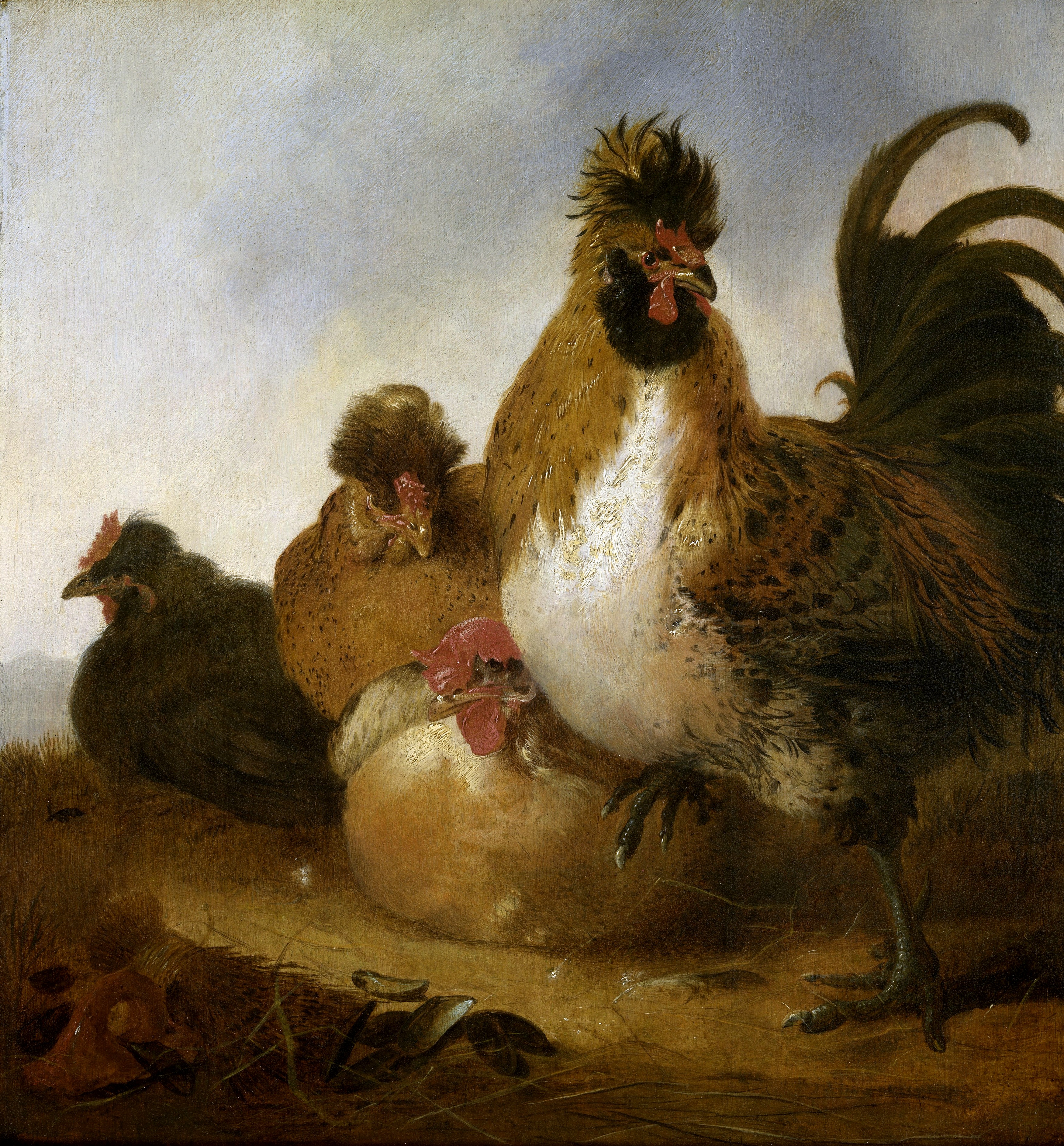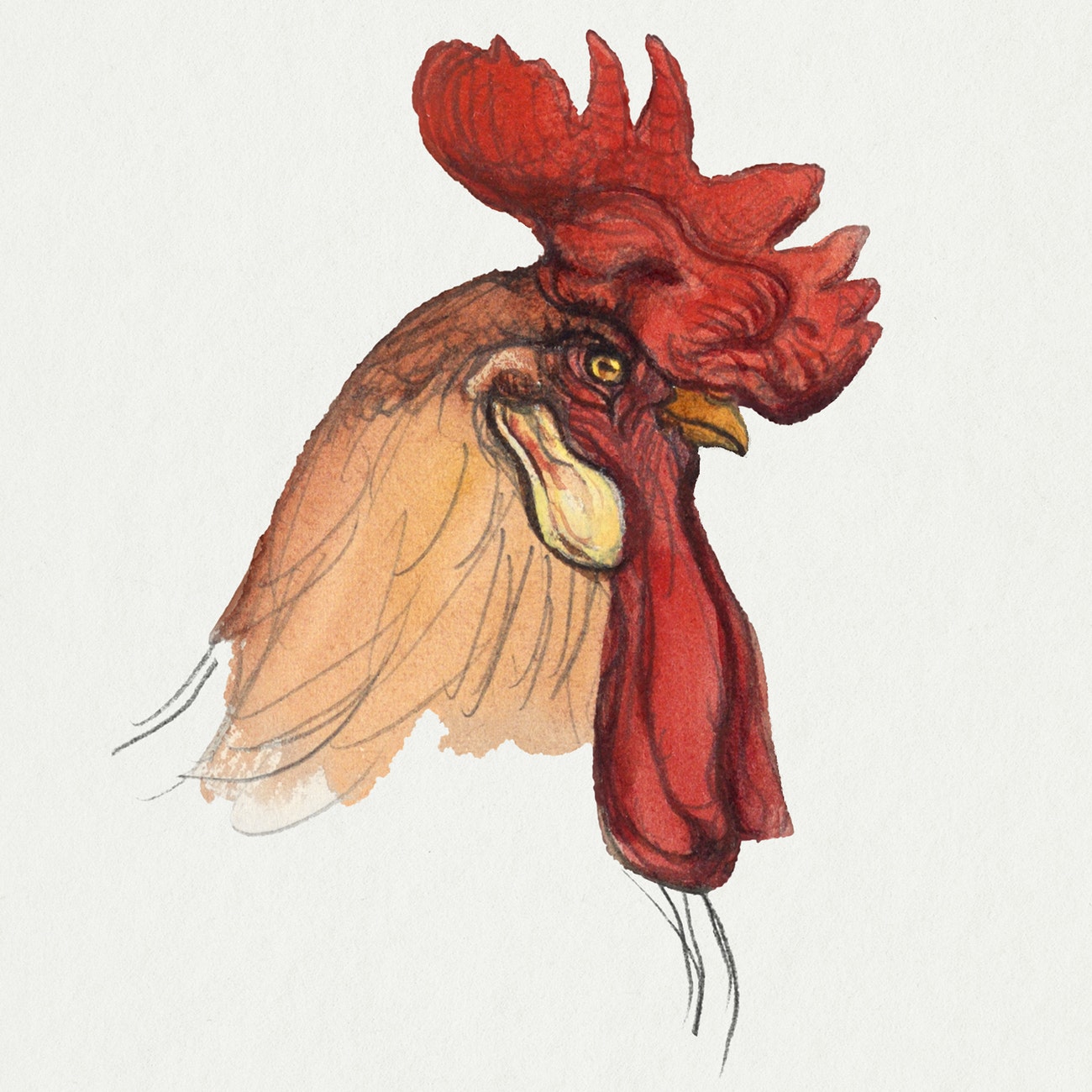Falcresti Red (Fahl-kress-tea Rehd)
Many variations of chickens, including specialized or localized breeds, can be found throughout Solia. In Falcrest, the Falcresti Red has been specialized to create larger, more protective roosters and more productive hens. Called "il Gallopetto" in Falcresti (Literally: Guard Chicken), the Falcresti Red has been the dominant selection for the last eighty years.
Basic Information
Anatomy
The Falcresti Red is a small bipedal ground-feeding avian with small, blunt wings, thick downy feathers, and hollow bones. Both genders have a free-hanging red wattle at the base of the toothless beak. Both genders have featherless digitigradelegs and anisodactyl feet.
The Falcresti Red, like most chickens, are terrestrial birds and considered reluctant flyers who are capable of flying for short and low distances but prefer walking or running.
Biological Traits
Sexual dimorphism is readily apparent in the Falcresti Red: Males are typically heavier but smaller than females, possess longer and ornate tail feathers and brighter plumage, as well as a brighter red wattle, with the addition of a comb or crown atop their head. Males also grow bone spurs on the posterior side of their leg up to one inch (2.54 cm) in length.
Genetics and Reproduction
Like other chickens, the female Falcresti Red is an egg-laying avian. Unlike other chickens, the Falcresti Red has been selectively bred so that a hen will consistently lay two to three eggs per day (every 6-10 hours) at its peak production in summer, for a typical clutch of 20-30 eggs that, when fertile, will hatch in roughly 20 days. Hens are light-sensitive and do not lay during dark hours, so production slows in late fall and winter, only to accelerate again in late spring.
Unlike most
humanoid species, a hen is capable of storing male sperm for up to 21 days. A hen may also reject and expel a male's sperm if she feels the male is an unsuitable mate1.
Growth Rate & Stages
Upon hatching, chicks will be covered in a soft yellow fuzz and require high temperatures (95º F / 35º C) for around one week, typically maintained by the brood hen who settles over the clutch and uses her own body heat. Chicks grow rapidly, with their first feathers coming in during their second week, and are fully feathered by week five. By week eight, a chick becomes a juvenile pullet or cockerel and is worked into the pecking order of the existing flock.
Adolescent cockerels begin practicing their crow around eight to ten weeks, while pullet hens begin to lay eggs around 15 weeks, compared to traditional hens who lay around 18 weeks. These eggs are smaller than mature hen eggs, but by 20 weeks the adolescents are considered adults and will be integrated into the flock completely.
Ecology and Habitats
The Falcresti Red, as the name suggests, is optimized for life in Falcrest. They can survive in most climates, though extreme prolonged cold (35º F/1.67º C) or extreme prolonged heat (125º F/51.67º C) reduce their productivity and can prove fatal.
Dietary Needs and Habits
The Falcresti Red is omnivorous, feeding on fruits, seeds, leaves, shoots, flowers, tubers, roots, insects, snails, worms, lizards, snakes, small rodents, and eggs (including their own if they are not receiving proper nutrients).
Biological Cycle
Egg production slows in late fall and winter and resumes in late spring until its peak in summer.
Additional Information
Social Structure
While the Falcresti Red integrate into a distinct social hierarchy, they do not mix well with other breeds of chickens and often drive off or kill any who attempt to integrate. This does not appear to be the case with other ground fowl, as ducks, turkeys, and pheasants have been successfully integrated into Falcresti Red flocks. Typical flocks contain one mature rooster, can contain a number of cockerel, and contain as many hens as their handlers consider reasonable. In the wild, a feral flock typically reaches a maximum size of twelve hens and one rooster.
Cockerels will often challenge the adult rooster for standing, with the winner gaining dominance and breeding rights over the flock, with the losing male either dead or reduced in standing. Hens, likewise, will maintain a strict hierarchy within the flock. They will often peck and harass younger or weaker hens to assert their dominance, and will go so far as to kill a rival.
Curiously, the Falcresti Red appear to consider their handlers as a part of their flock. While initially protective (aggressively so, see Domestication) of their flock, repeat introduction of handlers who pose no threat eases this defensiveness and, in turn, makes the chicken become protective of that person. Some occasions have shown that a Falcresti Red can identify family members of their primary handler and will 'adopt' them as well.
Domestication
No joke. I once watched my rooster chase off a bear. Big ol' bastard too, but he ran out of here like his fur was on fire!The Falcresti Red is a domesticated breed prized for its egg production, but also for the male's defensive nature. A male Falcresti Red functions as an aggressive guard of its flock, chasing off predators many times larger than itself. Females tend to also be very protective of their young, but will not chase a predator like the males. They have been observed knocking predatory birds from the air and killing them.
Uses, Products & Exploitation
The female Falcresti Red is prized for egg production and, when egg production has ended, as meat for eating. The male Falcresti Red tends to be tougher, and so is not commonly used for eating. They are instead used for breeding and guarding a flock and property. Some adventurers have trained Falcresti Red roosters as camp guards, much to the surprise of Golai and Heartfire Oroka who seek to do harm.
Geographic Origin and Distribution
Average Intelligence
The Falcresti Red proves to be an intelligent breed, showing a distinct social hierarchy, the ability to consciously choose a mate based on criteria, and their ability to communicate through various calls and sounds. Researchers speaking with samples of Falcresti Reds through magic have observed a range of intelligence and ability, but typically classify the animal on the high end of the animalistic intelligence.
Perception and Sensory Capabilities
The Falcresti Red has a well-developed visual ability that allows them to focus on both near and far objects at the same time, as well as the ability to perceive more colors than most
humanoid Species. The Falcresti Red is capable of hearing both low and high-frequency sounds, with some speculation that they are specialized in low-frequency sound (infrasound). The Falcresti Red also possesses a highly-developed sense of taste and smell, and are speculated to be sensitive to strong magnetic fields. The beak of the Falcresti Red is sensitive to touch and pressure.
Symbiotic and Parasitic organisms
A parasitic mite favors the blood of the Falcresti Red but can be easily treated with a diluted vinegar bath. Various rodent species prize their rich eggs, while predatory animals prey upon Falcresti Reds of all ages.
Civilization and Culture
Courtship Ideals
The male Falcresti Red will present himself to the female, fluff his feathers and prance before them to show his color, mobility, all accompanied by various vocalizations and calls. A female will respond with her own vocalizations and calls to let the male know if he has been selected or not.
Relationship Ideals
Most flocks tend to be based in polygyny, where a single dominant male mates with multiple females, but each female only mates with the dominant male. Non-dominant males will frequently be killed or driven off, in some cases taking lower-tier hens with them.
History
The Falcresti Red was first recognized as a unique breed in 1512, the result of generations of selective breeding by farmers in County Virdain who were trying to push for increased production due to a population boom.

Een haan en kippen. (Rooster and Hens) by Aelbert Cuyp
Genetic Ancestor(s)
Scientific Name
Reference Race: Chicken
Origin/Ancestry
Animal(Bird)
Lifespan
5-10 Years
Conservation Status
Due to increased laying rates, the Falcresti Red is a prolific breed considered common in Falcrest and most of Western Omath.
Average Height
Males: Up to 16 in (40.64 cm)
Females: Up to 22 in (55.88 cm)
Females: Up to 22 in (55.88 cm)
Average Weight
Males: 12-14 lbs (5.44-6.8 kg)
Females: 8-10 lbs (3.63-4.54 kg)
Females: 8-10 lbs (3.63-4.54 kg)
Body Tint, Colouring and Marking
Female feathers tend to be a pale red or soft yellow color, while male feathers tend to russet reds and dark blond hues, with dark red or dark brown tail feathers.
Geographic Distribution





Comments